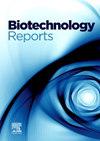Light intensity effects on bioproduct recovery from fuel synthesis wastewater using purple phototrophic bacteria in a hybrid biofilm-suspended growth system
Q1 Immunology and Microbiology
引用次数: 0
Abstract
This research looked at how three different light intensities (1600, 4300, and 7200 lx) affect the biomass development, treatment of fuel synthesis wastewater and the recovery of valuable bioproducts between biofilm and suspended growth in a purple-bacteria enriched photobioreactor. Each condition was run in duplicate using an agricultural shade cloth as the biofilm support media in a continuously mixed batch reactor. The results showed that the highest chemical oxygen demand (COD) removal rate (56.8 ± 0.9 %) was found under the highest light intensity (7200 lx), which also led to the most biofilm formation and highest biofilm biomass production (1225 ± 95.7 mg). The maximum carotenoids (Crts) and bacteriochlorophylls (BChls) content occurred in the suspended growth of the 7200 lx reactor. BChls decreased with light intensity in suspended growth, while in biofilm both Crts and BChls were relatively stable between light conditions, likely due to an averaging effect as biofilm thickened at higher light intensity. Light intensity did not affect protein content of the biomass, however, biofilm showed a lower average (41.2 % to 43.7 %) than suspended biomass (45.4 % to 47.7 %). For polyhydroxybutyrate (PHB) the highest cell concentration in biofilm occurred at 1600 lx (11.4 ± 2.4 %), while for suspended growth it occurred at 7200 lx (22.7 ± 0.3 %), though total PHB productivity remained similar between reactors. Shading effects from the externally located biofilm could explain most variations in bioproduct distribution. Overall, these findings suggest that controlling light intensity can effectively influence the treatment of fuel synthesis wastewater and the recovery of valuable bioproducts in a biofilm photobioreactor.

光强对混合生物膜悬浮生长系统中紫色光养细菌从燃料合成废水中回收生物产品的影响
本研究研究了三种不同的光强度(1600、4300和7200 lx)如何影响紫色细菌富集光生物反应器中生物质的发展、燃料合成废水的处理以及生物膜和悬浮生长之间有价值的生物产品的回收。采用农用遮光布作为生物膜支撑介质,在连续混合间歇式反应器中进行两种条件的试验。结果表明,在最高光照强度(7200 lx)下,化学需氧量(COD)去除率最高(56.8%±0.9%),生物膜生成量最高(1225±95.7 mg)。类胡萝卜素(Crts)和细菌叶绿素(BChls)含量在7200lx反应器悬浮生长时最高。在悬浮生长中,BChls随光强而下降,而在生物膜中,Crts和BChls在不同光照条件下相对稳定,可能是由于生物膜在较高光强下增厚的平均效应。光照强度对生物量蛋白质含量没有影响,但生物膜的平均蛋白质含量(41.2% ~ 43.7%)低于悬浮生物量(45.4% ~ 47.7%)。对于聚羟基丁酸盐(PHB),生物膜中的最高细胞浓度发生在1600 lx(11.4±2.4%),而悬浮生长的最高细胞浓度发生在7200 lx(22.7±0.3%),尽管反应器之间的PHB总产量相似。外部生物膜的遮阳效应可以解释生物制品分布的大多数变化。总之,这些研究结果表明,控制光强度可以有效地影响生物膜光生物反应器中燃料合成废水的处理和有价值生物产品的回收。
本文章由计算机程序翻译,如有差异,请以英文原文为准。
求助全文
约1分钟内获得全文
求助全文
来源期刊

Biotechnology Reports
Immunology and Microbiology-Applied Microbiology and Biotechnology
CiteScore
15.80
自引率
0.00%
发文量
79
审稿时长
55 days
期刊介绍:
Biotechnology Reports covers all aspects of Biotechnology particularly those reports that are useful and informative and that will be of value to other researchers in related fields. Biotechnology Reports loves ground breaking science, but will also accept good science that can be of use to the biotechnology community. The journal maintains a high quality peer review where submissions are considered on the basis of scientific validity and technical quality. Acceptable paper types are research articles (short or full communications), methods, mini-reviews, and commentaries in the following areas: Healthcare and pharmaceutical biotechnology Agricultural and food biotechnology Environmental biotechnology Molecular biology, cell and tissue engineering and synthetic biology Industrial biotechnology, biofuels and bioenergy Nanobiotechnology Bioinformatics & systems biology New processes and products in biotechnology, bioprocess engineering.
 求助内容:
求助内容: 应助结果提醒方式:
应助结果提醒方式:


